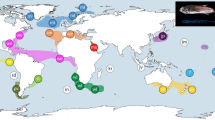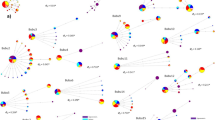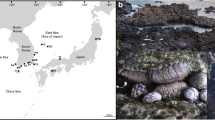Abstract
THE endangered Kemp's ridley sea turtle (Lepidochelys kempi) nests almost exclusively at a single locality in the western Gulf of Mexico, whereas the olive ridley (L. olivacea) nests globally in warm oceans. Morphological similarities between kempi and olivacea, and a geographical distribution that "... makes no sense at all under modern conditions of climate and geography"1 raise questions about the degree of evolutionary divergence between these taxa. Analysis of mitochondrial (mt) DNA restriction sites shows that Kemp's ridley is distinct from the olive ridley in matriarchal phylogeny, and that the two are sister taxa with respect to other marine turtles. Separation of olive and the Kemp's ridley lineages may date to formation of the Isthmus of Panama, whereas the global spread of the olive ridley lineage occurred recently. In contrast to recent examples in which molecular genetic assessments challenged systematic assignments underlying conservation programmes2–6, our mtDNA data corroborate the taxonomy of an endangered form.
This is a preview of subscription content, access via your institution
Access options
Subscribe to this journal
Receive 51 print issues and online access
$199.00 per year
only $3.90 per issue
Buy this article
- Purchase on Springer Link
- Instant access to full article PDF
Prices may be subject to local taxes which are calculated during checkout
Similar content being viewed by others
References
Carr, A. F. So Excellent a Fish: A Natural History of Sea Turtles (Scribner, New York, 1967; rev. edn, 1984).
Laerm, J., Avise, J. C., Patton, J. C. & Lansman, R. A. J. Wldf. Mgt. 46, 513–518 (1982).
Avise, J. C. & Nelson, W. S. Science 243, 646–648 (1989).
Avise, J. C. Trends Ecol. Evol. 4, 279–281 (1989).
O'Brien, S. J. & Mayr, E. Science 251, 1187–1188 (1991).
Daugherty, C. H., Cree, A., Hay, J. M. & Thompson, M. B. Nature 347, 177–179 (1990).
Hildebrand, H. H. Ciencia, Mexico 22(4), 105–112 (1963).
Ross, J. P., Beavers, S., Mundell, D. & Airth-Kindree, M. The Status of Kemp's Ridley (Center for Marine Conservation, Washington, DC, 1989).
Magnuson, J. J. et al. Decline of the Sea Turtles (National Academy, Washington, DC, 1990).
Garmen, S. Bull. Mus. Comp. Zool. Harvard Univ. 6(6), 123–126 (1880).
Carr, A. F. Proc. New Engl. Zool. Cl. 21, 1–16 (1942).
Ditmars, R. L. The Reptiles of North America (Doubleday, Doran, Garden City, New York, 1936).
Loveridge, A. & Williams, E. E. Bull. Mus. Comp. Zool. Harvard Univ. 115, 163–557 (1957).
Pritchard, P. C. H. & Trebbau, P. The Turtles of Venezuela Contrib. to Herpetol. 2., Society for the Study of Amphibians and Reptiles (Fundacion de Internados Rurales, Caracas, Venezuela, 1984).
Woody, J. B. in Audubon Wildlife Report 1986 (ed. DiSilvestro, R.) 919–931 (Natl Audubon Society, New York, 1986).
Zangerl, R. & Turnbull, W. D. Fieldiana: Zool. 37, 345–382 (1955).
Nei, M. Molecular Evolutionary Genetics (Columbia University Press, New York, 1987).
Hendrickson, J. R. Am. Zool. 20, 597–608 (1980).
Pritchard, P. C. H. thesis, Univ. Florida, Gainesville (1969).
Hughes, G. R. Biol. Cons. 4(2), 128–134 (1972).
Briggs, J. C. Marine Zoogeography (McGraw-Hill, New York, 1974).
Nei, M. & Li, W.-H. Proc. natn. Acad. Sci. U.S.A. 76, 5269–5273 (1979).
Mayr, E. Animal Species and Evolution (Harvard University Press, Cambridge, Massachusetts, 1963).
Avise, J. C. & Ball, R. M. Jr Oxf. Surv. Evol. Biol. 7, 45–67 (1990).
Lansman, R. A., Shade, R. O., Shapira, J. F. & Avise, J. C. J. molec. Evol. 17, 214–226 (1981).
Sneath, P. H. A. & Sokal, R. R. Numerical Taxonomy (Freeman, San Francisco, 1973).
Swofford, D. L. & Olsen, G. L. in Molecular Systematics (eds Hillis, D. M. & Moritz, C.) 411–501 (Sinauer, Sunderland, Massachusetts, 1990).
Bowen, B. W., Meylan, A. B. & Avise, J. C. Proc. natn. Acad. Sci. U.S.A. 86, 573–576 (1989).
Brown, W. M., George, M. Jr & Wilson, A. C. Proc. natn. Acad. Sci. U.S.A. 76, 1967–1971 (1979).
Author information
Authors and Affiliations
Rights and permissions
About this article
Cite this article
Bowen, B., Meylan, A. & Avise, J. Evolutionary distinctiveness of the endangered Kemp's ridley sea turtle. Nature 352, 709–711 (1991). https://doi.org/10.1038/352709a0
Received:
Accepted:
Issue Date:
DOI: https://doi.org/10.1038/352709a0
This article is cited by
-
Global phylogeography of ridley sea turtles (Lepidochelys spp.): evolution, demography, connectivity, and conservation
Conservation Genetics (2022)
-
Establishing the foundation for an applied molecular taxonomy of otters in Southeast Asia
Conservation Genetics (2008)
-
Bear conservation genetics
Nature (1992)
Comments
By submitting a comment you agree to abide by our Terms and Community Guidelines. If you find something abusive or that does not comply with our terms or guidelines please flag it as inappropriate.



